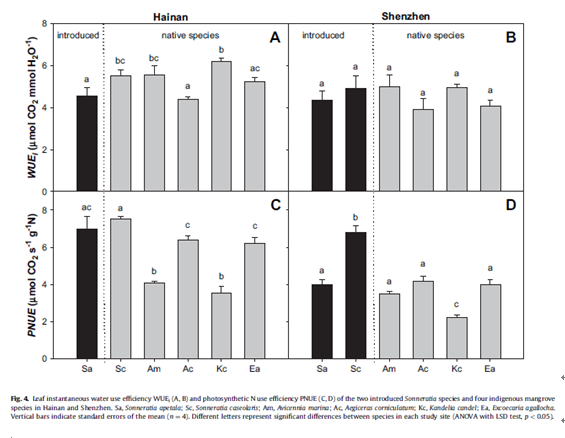Chen L.Z., Tam N.F.Y., Huang J.H., Zeng X.Q., Meng X.L., Zhong C.R., Wong Yuk-shan., Lin G.H.Estuarine, Coastal and Shelf Science, 2008.79:644-652.
Due to its rapid growth, the introduced mangrove speciesSonneratia apetalafromBangladeshhas been widely used in mangrove restoration in southeasternChinasince 1985. As an indigenous mangrove species inHainan,China,Sonneratia caseolariswas also planted inGuangdongProvincefor afforestation purposes. Both species have developed well in their new habitats, but their ecophysiological differences with the native mangrove species have not been studied. In this study, leaf gas exchange, water and nitrogen use efficiencies of twoSonneratiaspecies were compared with those of selected native mangrove species (Avicennia marina,Aegiceras corniculatum,Kandelia candel, andExcoecaria agallocha) inHainanand Shenzhen. The introducedS. apetalamaintained lower carbon assimilation rate (A) and photosynthetic nitrogen use efficiency (PNUE) than the indigenousS. caseolaris. In Shenzhen, the two introducedSonneratiahad comparable photosynthetic rates and water use efficiency (WUE) with the native mangrove species, except thatPNUEinS. caseolariswas significantly higher than in the native mangrove species. The twoSonneratiaspecies showed significant overlap inPNUEand long-termWUE. Photosynthetic parameters derived from leaf photosynthetic light–response curves andA–Cicurves also suggested lower carbon assimilation capacities for the introducedSonneratiathan for the native mangrove species in both study sites. The lower light compensation point (LCP) of two introducedSonneratiain both study sites also indicated a better adaptation to a low light regime than the native mangrove species. The results of photosynthetic capacities indicated that the introduced mangrove species have little competitive advantage over local native mangrove species in their respective new habitats.


